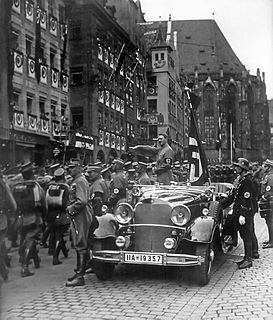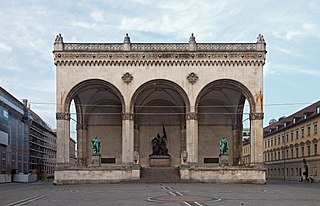 W
WThe Beer Hall Putsch, also known as the Munich Putsch, was a failed coup d'état by Nazi Party leader Adolf Hitler, Generalquartiermeister Erich Ludendorff and other Kampfbund leaders in Munich, Bavaria, on 8–9 November 1923, during the Weimar Republic. Approximately two thousand Nazis marched on the Feldherrnhalle, in the city centre, but were confronted by a police cordon, which resulted in the deaths of 16 Nazi Party members and four police officers.
 W
WThe Blood Order, officially known as the Decoration in Memory of 9 November 1923, was one of the most prestigious decorations in the Nazi Party (NSDAP). During March 1934, Hitler authorized the Blood Order to commemorate the 9 November 1923 coup attempt of the Nazi Party. The medal is silver, with the obverse bearing a depiction of an eagle grasping an oakleaf wreath. Inside the wreath is the date 9.Nov. and to the right is the inscription München 1923–1933. The reverse shows the entrance of the Feldherrnhalle in relief, and directly above is the angled swastika with sun rays in the background. Along the top edge is the inscription: UND IHR HABT DOCH GESIEGT.
 W
WThe Blutfahne, or Blood Flag, is a Nazi Party swastika flag that was carried during the attempted coup d’etat Beer Hall Putsch in Munich, Germany on 9 November 1923, during which it became soaked in the blood of one of the SA men who died. It subsequently became one of the most revered objects of the NSDAP. It was used in ceremonies in which new flags for party organizations were consecrated by the Blood Flag when touched by it.
 W
WThe Honor Temples were two structures in Munich, erected by the Nazis in 1935, housing the sarcophagi of the sixteen members of the party who had been killed in the failed Beer hall putsch. On 9 January 1947 the main architectural features of the temples were destroyed by the U.S. Army as part of denazification.
 W
WHermann Ehrhardt was a German Freikorps commander during the period of turmoil in Weimar Republic Germany from 1918 to 1920, he commanded the famous II.Marine Brigade, better known as the Ehrhardt Brigade or Marinebrigade Ehrhardt.
 W
WThe Feldherrnhalle is a monumental loggia on the Odeonsplatz in Munich, Germany. Modelled after the Loggia dei Lanzi in Florence, it was commissioned in 1841 by King Ludwig I of Bavaria to honour the tradition of the Bavarian Army.
 W
WThe People's Courts of Bavaria were Sondergerichte established by Kurt Eisner during the German Revolution in November 1918 and part of the Ordnungszelle that lasted until May 1924 after handing out more than 31,000 sentences. It was composed of two judges and three lay judges. One of its most notable trials was that of the Beer Hall Putsch conspirators, including Adolf Hitler, Erich Ludendorff, Wilhelm Frick, Friedrich Weber, and Ernst Röhm, which lasted from 26 February 1924 until 1 April 1924.